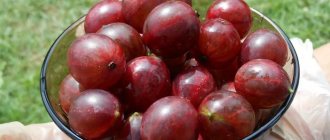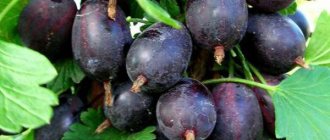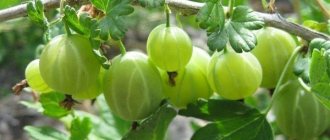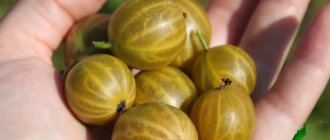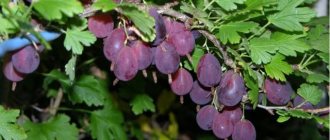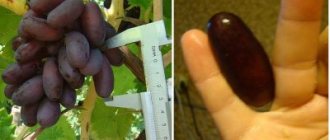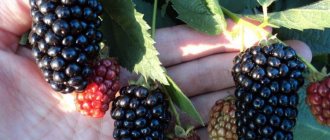Characteristics and description of bushes
Plant characteristics:
- The bush is medium spreading with vertical, not too thick shoots. Reaches a height of up to 1.5 m.
- There is a slight thorniness, because breeders have not been able to develop a variety that is completely devoid of thorns.
- In spring, the branches are covered with green three-lobed leaves that have wrinkled plates without pubescence.
- During the flowering period (in the second half of April or early May), beautiful crimson flowers appear on the shoots. Their diameter does not exceed 12 mm. Over time, the buds turn white and fall off.
Temperature resistance
The variety has high frost resistance and adapts well to hot summers. In winter, the bush is not damaged under the influence of severe temperatures down to -30°C.
Moisture and drought resistance
Gooseberries can withstand short droughts well. Moisture deficiency negatively affects the fruit: the berries become small and sour.
Resistance to diseases and pests
The Ural thornless is rarely affected by septoria and powdery mildew, but is regularly attacked by pests.
Diseases and pests, methods of control and prevention
The Ural thornless gooseberry variety has strong immunity to most diseases, but can be attacked by pests. Preventive measures are carried out twice per season - in spring and autumn.
There are many pest control products on the market, but experienced gardeners also recommend using traditional methods. It will be effective to quickly pour water on the bush at the beginning of April, heated to a temperature of +80 ° C. After this procedure, all debris from under the bush should be collected and burned.
At the beginning of budding, gooseberries should be sprayed with Rovikurt. This will protect the bush from aphids, gall midges and sawflies. A solution of colloidal sulfur will be effective against pests that damage buds.
Advice! It is better to use modern biological products against diseases and pests - they are effective and safe.
In autumn, sanitary treatment of gooseberry bushes is mandatory. Sick and damaged leaves and shoots are removed. The plant itself and the ground around it must be treated with nitrophen, then watered abundantly and mulched with a thick layer of peat.
Characteristics and description of fruits
The first berries appear in the second or third year after planting. The bush begins to bear fruit in mid or late July. The fruits are large in size. One berry weighs up to 8 g.
The fruits are oval in shape and emerald green in color. The skin has a dense structure. The pulp is juicy, with a pleasant dessert taste with slight sourness.
Reference. The berries have a rich chemical composition. They include vitamins (A, C, group B, PP), acids (citric, tartaric, malic), micro- and macroelements (copper, iron, calcium, magnesium, potassium, iodine and others).
Areas of use
The berries are consumed fresh, and jams and preserves are prepared from them. Gooseberries are well suited for making compotes, adding to baked goods and desserts. Many gardeners grow this variety for subsequent sale.
Planting and care
Young seedlings can be planted from late September to mid-October. Moreover, this is the main advantage of such planting - you can count on fruiting already in the spring of next year. Planting is done as follows:
- The soil should be prepared approximately 2 or 2.5 months before planting. If the soil on the site is loamy, then it is necessary to add sand; if there is sandy loam, clay.
- When digging a hole, we put the top fertile layer in one direction, the bottom in the other. The depth of the hole should be at least 40 centimeters, and the same in diameter.
- However, such dimensions, of course, are more suitable for black soil, but if the land on the site is poorer, then it is advisable to expand it to 50 by 70 centimeters or even more. Thus, you will improve the fertile qualities of the land at the planting site - by introducing more manure, humus, phosphate rock and potassium salt into the soil.
- Line the bottom of the planting hole with a layer of wood chips; This is drainage necessary for better nutrition of the plant's root system. And before lowering a bush seedling into the hole, you need to pour a bucket of water into it.
- There should be a distance of at least 1-1.5 meters between bushes, and 1.5-2 meters between rows of plantings. The thing is that the feeding area of each bush will be approximately 2-2.2 square meters.
- For better watering, you need to form a hole around the plant, first compacting the soil. And a day after the first watering, the soil will also need to be mulched. This way you will maintain the water balance in the soil and damage various weeds. Peat, tree bark and sawdust are good for mulching. If mass planting is planned, then it is better to use the trench method.
About
Advantages and disadvantages of the variety
Ural thornless gooseberry has many advantages. Among them:
- high yield rates (up to 5 kg of berries are harvested from a young bush, up to 9 kg from an adult bush);
- slight thorniness (some shoots lack thorns);
- excellent dessert taste of fruits;
- high content of useful vitamins and microelements;
- good winter hardiness;
- low maintenance requirements;
- resistance to main types of diseases (powdery mildew, septoria);
- decorative effect of bushes during the flowering period.
Disadvantages include severe fruit shedding (delayed harvesting leads to the loss of a large number of berries) and poor tolerance to prolonged drought.
Harvesting and transportation
The crop is characterized by medium ripening periods, but high fruit shedding forces gardeners to start harvesting a little earlier. During fruiting, the berries are removed from the bush regularly. Sometimes gardeners lay fabric under the bushes to avoid losing fallen fruits.
Fresh berries, due to their elastic skin, tolerate transportation well and can be stored. Ripe fruits are well preserved in the refrigerator for up to 5 days, and unripe ones for up to 10 days. Gooseberries can be frozen or dried to make delicious jam or jam.
We recommend finding out how long a gooseberry bush lives.
The rules for planting and caring for Ural thornless gooseberries are quite simple, so that even a novice gardener can easily master them. With a little diligence, love and care, you can easily grow this wonderful plant on your plot, receiving a good harvest of healthy fruits as a reward.
Ural thornless gooseberry, cultivation technology
Despite its unpretentiousness, the crop still requires some attention from the gardener. The following recommendations will help beginners in the process of growing Ural thornless gooseberries.
Optimal conditions
Gooseberries love well-lit sunny areas or light partial shade. Too dark corners of the garden negatively affect the crop: the plant develops and bears fruit poorly, and is constantly sick. Strong drafts are also avoided, since strong winds cause even greater fruit fall.
The variety prefers to grow in moist soil, but does not tolerate stagnant water and wetlands. The depth of groundwater is also taken into account: it is good if it is located at a distance of at least 1 m from the root system.
Landing dates and rules
The optimal time for planting a bush is the end of September or the beginning of October. Before the start of winter, the plant will get used to the new place and overwinter well. Experienced gardeners carry out planting work in the spring. But this method requires proper preparation of seedlings before buds open, so it is not suitable for beginners.
In order for gooseberries to take root and begin to bear fruit after 2 years, gardeners follow certain planting rules:
- Selection of planting material. Seedlings are purchased from nurseries or from trusted sellers. Select only two-year-old material 20-25 cm long, with 3-4 healthy buds and a well-developed root system.
- Preparation of bushes. Planting takes place immediately after purchase. First, the shoots are shortened by 10-12 cm, and the roots are moistened in water at room temperature. If planting is delayed for some time, the rhizome is soaked in a clay mixture, wrapped in a damp cloth and placed in a bag.
- Formation of holes. Planting holes are prepared 1-2 months before planting gooseberries. During this time, the earth will be saturated with useful fertilizers. Holes are dug in the area with a depth of about 50 cm and a diameter of about 40 cm. The bottom is enriched with fertilizers: 5-6 kg of manure is poured into one hole, 30 g of superphosphate and potassium salt are added. When forming several holes, a distance of 1-1.5 m is maintained between them. 2-2.5 m are left between the rows.
- Landing. The seedlings are placed in holes, the roots are carefully straightened, and half of the soil is buried. 5 liters of water are poured under the bush and the remaining soil is added. Water again, mulch the soil with humus, peat or dry soil.
The planting process does not change when performing spring planting work. Gooseberries are provided with comfortable conditions for development, following all care recommendations.
Further care
Gooseberries love moisture, quality nutrition, and loose soil. Therefore, gardeners perform the following types of activities:
- Watering. The plant is watered 3 times every 7 days, pouring out 8 liters of water. Adult bush - 1-2 times every 7 days, water consumption remains the same. In drought, the dose is increased to 10-15 liters. Watering is completely stopped 5-7 days before picking the berries. At the end of September, the bush is saturated for the last time, giving it 30-40 liters of liquid.
- Feeding. Nutrients are added only in the second year after planting. The first time gooseberries are fertilized in early spring to cause the awakening and growth of shoots. To do this, add 6 kg of manure to the tree trunk circle, simultaneously loosening the soil. Before flowering, add 5 liters of mullein (20 g diluted in 10 liters of water). During the growing season, spraying is carried out with purchased mineral compounds. After harvesting, fertilizers from the store are applied to the ground, including the main elements - potassium and phosphorus.
- Loosening and weeding. The soil is loosened once every 3 weeks to a depth of about 10 cm. At the same time, weeds are removed. The procedure is performed the first 2-3 years after planting.
The bush is regularly inspected for damage, dry and diseased branches. The latter must be destroyed. Throughout the year, 2 main prunings are performed:
- Prophylactic treatment is carried out in early spring, during the period of bud swelling. Remove damaged stems: frozen, broken.
- The autumn one is performed in October, after the harvest. The bush is freed from shoots older than 5 years: they are dark in color. Additionally, shoots and damaged branches are removed.
- Rejuvenating pruning is performed when the gooseberry reaches 10 years of age. Here all branches are cut off, leaving shoots 10-15 cm long.
To give a neat appearance, a support is made around the bush. Drive in wooden stakes and pull the wire so that a square or rectangle is formed.
Attention! Removing shoots is permissible only with sharp pruning shears pre-treated with potassium permanganate. The cut areas are generously covered with garden varnish. The drug accelerates wound healing.
Possible problems, diseases, pests
When growing Ural thornless gooseberries, gardeners do not encounter any problems, but only if all recommendations for choosing a site, planting and subsequent care have been followed.
Despite its resistance to many types of diseases, the variety is susceptible to fungal infections. Gardeners often find:
- white coating on foliage and fruits, which indicates the presence of powdery mildew;
- white spots that appear when a bush is infected with septoria;
- brown spots and dry leaves with fruits - anthracnose;
- yellow or orange formations on shoots and foliage due to rust damage.
Damaged stems are burned. The bushes are treated with “Topaz” and “Fundazol”.
The threat is posed by leaf rollers, spider mites, moths, scale insects, aphids, and copperheads. Pests are destroyed by spraying with insecticides "Aktara", "Confidor Extra".
Reference. To prevent the appearance of pests, experienced gardeners spray the bushes with boiling water (+80°C). Before the buds swell, during budding, after harvesting - with a solution of copper sulfate (50 g of powder is diluted in 10 liters of water).
Wintering
The bush is prepared at the end of September. They perform pruning, weeding, remove all biological debris, loosen the soil to a depth of 5 cm. In the middle and southern regions they do without shelter. In northern cities, gooseberries are covered with spruce branches.
Reproduction
Gooseberries are propagated by cuttings, dividing the bush, perennial branches and layering. The simplest and most popular method is to divide an adult bush.
The procedure is carried out after fruiting has ended. The bush is dug up and divided into several parts. Choose stronger fragments with a well-developed root system. They are planted in loose, fertilized soil. The planting principle and care rules are the same as for newly purchased seedlings.
Follow-up care for gooseberries
In the first year after planting, no fertilizer will be required. In the second year, fertilizing with organic matter is necessary. In the third year, wood ash and superphosphate are used. Next, you need to feed the gooseberries once every 2-3 years.
The plant requires the following care measures:
- watering;
- weed removal;
- loosening;
- feeding;
- treatment against pests and diseases;
- pruning;
- mulching.
When watering under a bush, it is enough to pour a bucket of water as the soil dries out, even if the plant has recently been planted.
Advice! Watering gooseberries during fruiting should not be abundant, otherwise it will affect the taste of the berries - they will become more sour.
The next year after planting the bush, pruning is carried out. In this way, the productivity of the plant can be increased. First, zero shoots are removed, leaving the 5–6 strongest ones. The bush should have branches of different ages, with the exception of those that are more than 7 years old. Old and diseased parts of the plant must be removed. Anti-aging pruning is carried out when the crop reaches 10 years of age.
In Siberia, gooseberries must be covered for the winter by bending the branches to the ground. In warmer climates it will survive cold weather without problems.
Reviews from summer residents
Gardeners speak positively about this variety, noting its good yield and high taste.
Galina, Novy Urengoy: “The gooseberry made me happy. After planting, it immediately took root, withstood frosts well, and bloomed safely. The berries are really large; we collected almost 6 kg from one bush.”
Dmitry, Aramil : “The main advantage of this variety is the minimum number of thorns. Children eat berries straight from the bush. The fruits are large and sweet, so everyone eats them. There’s no left for jam or compotes.”
Natalia, Vladimir: “Gooseberries are good for everyone, but if you don’t pick them on time, there will be no berries left. They are quickly eaten by birds. Next time I’ll try not to miss the harvest deadline.”
Peculiarities
Of course, breeders have not yet managed to develop varieties that are completely devoid of thorns. Gardeners continue to argue about the taste characteristics of thornless varieties. Many are sure that their berries are sweeter than those of other types of their favorite crop. Experts believe that the taste of the fruit directly depends on the characteristics of each of the many varieties.
As for the description of the Ural thornless gooseberry bush, its bushes have an average degree of density, are vigorous and medium spreading. Branches usually grow in a vertical direction. The shoots are also medium thick and grayish-yellow in color. Single buds of light brown color with a sharp tip appear on them. The description of the foliage is as follows. It is green in color, has no pubescence on its surface, is wrinkled and rather leathery. The leaves are somewhat wavy and three-lobed. The leaf petiole is about 2 cm long. On this best of the thornless varieties you can see flowers measuring about 12 mm in size. The buds are usually colored a beautiful crimson shade.
Large berries appear on the bush, each weighing about 8 grams. If we talk about the description, they have an oval shape, a matte surface and are emerald green. Covered with thick skin. The pulp of the Ural gooseberry, which belongs to the thornless varieties, is endowed with a pleasant dessert taste.
The peculiarities of this type of crop include the rich chemical composition of the fruit. It contains dry substances in the amount of 12.8%, sugars - about 9.9%, P-active substances - 234.0 mg per 100 grams, ascorbic acid - 23.5 mg per 100 grams, titratable acidity is 2.1 %. Also, the advantages of this one of the best varieties of rose hips are excellent winter hardiness (even in harsh winters its indicator is 2 points), large fruit, excellent taste of berries, resistance to various diseases, high yield - by the age of 5 years it can reach 5.5 kg and up to 7 - 9 from each adult plant. The beginning of fruiting of the Ural variety shrub should be expected already 2 - 3 years from the moment of planting. The purpose of the fruits of such a crop is universal. They are equally good when eaten fresh and for preparing a variety of preparations for the winter.
Read also: What fertilizers should I apply when planting tomatoes?
The best varieties of gooseberries with large fruits
"Defender"
A plant with tall, powerful branches and an even crown.
Represents large varieties. The weight of one berry is up to 10 g, the shape is oblong-pear-shaped, the skin color is dark burgundy. The taste of the fruit pulp is sourish-sweet. “Defender” refers to varieties with early ripening. The variety is resistant to low temperatures and has immunity against powdery mildew.
"Candy"
The bushes of the plant are covered with thorns.
The fruits are large, the weight of one varies from 3 to 5.9 grams. The color of the berries is pink, the pulp is sweet and sour in taste, and has a wonderful aroma. “Candy” is frost-resistant and does not require pollination. Each season brings from 1.9 to 6.3 kg per bush. Has immunity against powdery mildew and anthracnose.
This variety has a minus: “Candy” often becomes a victim of septoria. It is recommended to grow in the regions of Western and Eastern Siberia.
"Cooperator"
It has a medium late ripening period.
A medium-sized plant with a slightly spreading crown. The branches have practically no thorns. The weight of one berry is about 7 grams, the shape is pear-shaped, the color of the skin is deep red. The pulp is tasty and sweet. You can collect up to 5 kg of berries from one bush. "Cooperator" is a dessert variety. The species is not susceptible to fruit rot and is frost-resistant.
"Leningrader"
A medium-sized plant with a semi-spreading crown, with a small number of thorns on the branches. It has a medium late ripening period. The fruits are large, egg-shaped, each weighs about 10 grams. The color of the berries is red, the pulp tastes sweet and sour. During the season, you can collect up to 7.6 kg of mature gooseberries from one bush. "Leningradets" tolerates low temperatures well and is not susceptible to the spread of powdery mildew.
"Spring"
The plant is of medium height and forms a neat crown. The weight of one berry is from 5 to 6 grams; with proper care, the weight can increase to 8 grams. The fruits have a round, oblong shape. The skin is dense, yellowish-green in color. The fruit pulp is sweet and tasty. Can be consumed both fresh and processed. “Rodnik” tolerates frost well and is resistant to the appearance and spread of fungal diseases.
Interesting! Unfavorable weather conditions will not prevent you from harvesting a rich harvest from the bush.
Agricultural technology varieties
If planting is carried out correctly in the first year, fertilizing will not be required, since all the necessary nutrients were added to the seedling hole.
In the second year, it is worth adding organic fertilizers such as manure, which is rich in nitrogen. In the third year, it is permissible to use wood ash and superphosphate. In the future, fertilization is carried out once every 2–3 years .
To protect gooseberries from pests and diseases, it is better to use biological products.
Comprehensive shrub care includes:
- watering;
- weeding;
- loosening;
- treatment and prevention of diseases and pest attacks;
- feeding;
- pruning;
- mulching.
On hot days, the variety requires an average of 1 bucket per bush, provided there is no precipitation, but only if the gooseberries were recently planted.
If the plant is fruit-bearing, then the watering rate increases to 3-4 buckets . However, watering the plants must be stopped several days before the fruiting period, otherwise the taste of the berries will be spoiled by the increased sourness.
You can increase the yield by timely pruning the bushes. The procedure is carried out the next year after planting the plant.
- First of all, zero shoots are cut out, among which 5–6 of the most powerful ones .
- Old, dried out and diseased branches of the bush must be pruned.
- Normally, a gooseberry bush should have 10–14 branches of different ages , and among them there should be no branches older than 7 years.
- Only in this case will the culture demonstrate the highest performance.
- Anti-aging pruning is done when the plant reaches 10 years .
Gardeners who grow the Ural thornless variety in their garden plots talk about the excellent taste of the shrub and the ease of harvesting.
But they also note the good productivity and versatility of the fruit, which can be used both in home canning and freezing.
Description of the variety
The Ural thornless gooseberry variety was bred by Russian breeder V.S. Ilyin .
The bush is distinguished by an average degree of spreading and density, with good branching.
- The plant is vigorous with vertical branches. Side branches may have a slight angle of inclination.
- Lignified rosehip shoots are gray-yellow in color and of medium thickness.
- Green annuals are quite powerful, without characteristic pubescence.
Buds and thorns
“Ural thornless” is a gooseberry with a “soft character”.
- The buds of the bush are light brown, medium and oblong with a slightly pointed top without pubescence. They are diverted from the main shoot by 40–45° .
- Apical bud of free type.
- There are practically no thorns.
Gooseberry leaves are three-lobed, small in size with a pronounced middle lobe.
Dark green leaves without pubescence.
- They are characterized by a rich dark green hue and a glossy surface.
- The structure of the leaf plate is wrinkled, the shape is concave.
- There are small teeth along the edge, the top is slightly rounded.
- The veins on the leaf blade are light green.
- The base is slightly rounded with a shallow open notch.
- The petiole is no more than 2 cm, green with thickening, located at an angle of 40–45° relative to the shoot, the pubescence of the petiole is weak.
Read also: How to preserve carrots for the winter - useful news From the garden
Flowering begins in late April or early May.
- The flowers of the shrub are small, 10–12 mm in diameter.
- Initially, the buds have a bright crimson color with intensely colored sepals.
- Over time, they turn pale, the sepals are colored more evenly and do not intersect with each other.
- The pink tint of the flowers subsequently fades.
Productivity and berries
The Ural thornless variety demonstrates good performance. At the age of up to 5 years, the yield is 5.5 kg, after which it reaches 7–9 kg.
The variety begins to bear fruit at 2–3 years.
- Gooseberries are large ( 7–9 grams ), oval in shape, rich emerald hue, without pubescence with a beautiful matte sheen.
- Fruit detachment is easy. The pulp is juicy and sweet, the skin contains notes of sourness, and it itself is quite dense.
- The color of the veins is lighter than the main tone.
- The peduncle is bright green. The variety is characterized by strong crumbling.
The highest yields are demonstrated by 5–6 year old plants.

